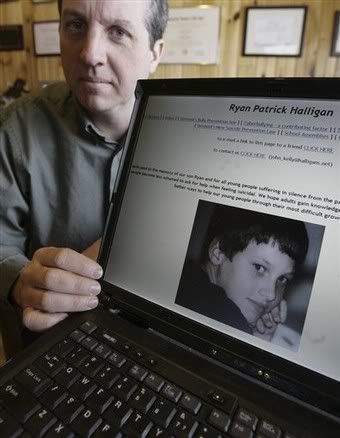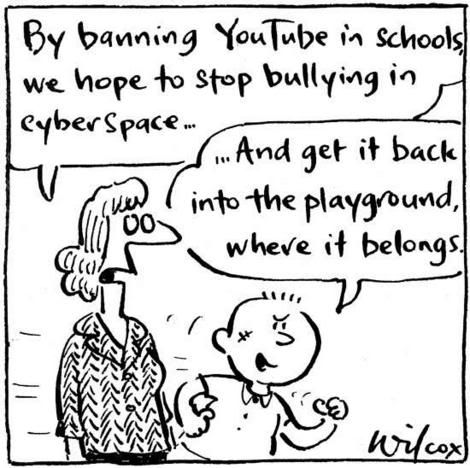Written by azhar.
Names used are fictitious.
Two years ago, two of my classmates were the masterminds behind an insidious plot to bully an innocent schoolmate. Her name was Honey. She was obese and had a weird behaviour. Everyone ridiculed her online eccentricities - she would always boast about guys chasing after her. My classmates, Jasmine and her accomplice, Jenny, decided to create an entirely fake Friendster account and use it to 'befriend' their target. They were curious and wanted to know who the guys were as there were no pictures posted in her Friendster profile. It was an attempt to prove if she was fabricating the stories or otherwise.
And so, Dave was born. Dave's job was simple. He would 'befriend' Honey and exchange messages with her. Jasmine and Jenny brainstormed Dave's personal information that would be included in his Friendster profile. Everything was made up, of course. After Dave's particulars were finally recorded, they registered his profile and within minutes it was ready, complete with a new profile layout and pictures that they grabbed in the Internet.
For the next two months, Jasmine and Jenny had a lot of fun sharing the personal messages from Honey to their friends including me. The whole class would crowd around the school computer and laugh at the messages. It was very obvious that Honey trusted Dave completely even though they never met! She would share almost everything about her life to Dave. However, this was not the end. Jasmine and Jenny were elated by the success and they had plans to share it with the entire school population.
Since Honey's Friendster account was private, only friends that she accepted could receive and read the messages online. Jasmine and Jenny wanted to expose the messages between Dave and her by posting it in a blog, so that everyone could view it any time. To prevent readers from suspecting that the blog was not genuine, they decided to update about Dave's personal life. Everything they blogged about was fiction.
Dave's blog and Friendster profile soon became very popular in school. For the first time, all my schoolmates could witness and decide for themselves if Honey was just fabricating her love stories or otherwise. We grew more convinced that she was indeed living in a fantasy world of her own: She claimed that she had met with Dave in her instant messenger display name. It was not true. Dave was merely an online fictitious character. He never existed.
As months passed by, news broke out that Honey had discovered the blog and was depressed after reading it. There were rumours that she would cry every time she visited the blog. Honey stopped contacting Dave as soon as she detected the (evil) plot. No one really knew what happened to her hereafter. She did not have many friends. Her classmates alienated as much as we did. Dave's Friendster account and blog soon died in weeks.
If the blog was still 'alive' up to date, my classmates and I would be celebrating its 3rd anniversary. As I reminisced about the past, I felt grateful it never lasted that long. The consequences would be dreadful if it did. I stumbled upon news that many teenagers had committed suicide after being mortified online. Little did I know that my classmates and I had actually committed a serious offence two years back - cyber bullying. We never thought of the harmful consequences that would affect our target. All we wanted was evidence that our victim was living in a fantasy world of her own.
Cyber bullying involves the use of information and communication technologies to taunt and harm an individual or a group intentionally and repeatedly. Cyber bullies utilize the Internet to inflict emotional pain to their victims and sometimes injure the dignity of their targets. These online predators usually remain anonymous as they erode their prey's self-esteem.
Ryan Halligan was a 13-year-old boy from Vermont in the USA. In school, he was constantly taunted for months as being homosexual. Classmates started to spread the rumour via instant messaging. A popular female classmate then pretended to be interested in him and chatted with him online regularly, before exchanging and forwarding the conversation to her friends. Unable to cope with the humiliation, Ryan committed suicide.
Ryan is only one of the hundreds of teenagers out there being bullied online. A 2007 study by the US-based Pew Internet & American Life Project found that one-third of American teenage internet users have been targets of online ruffians. The emergence of social-networking websites has also taken cyber bullying into a whole new level - more public and collaboration. Cyber bullying has become more 'deadly' than the usual schoolyard bullying. Below are the reasons why:
It is more public
In the past, bullying usually occurred in schools. The offenders would choose their targets and torment their victims with physical or verbal bullying. The most common were name-calling, teasing and sometimes kicking or hitting the victims. Such instances would happen during breaks in school, usually within the bully's circle of friends or classmates. The target would be dragged into a secluded place, away from the rest of the school population, so that no one could witness and inform the teachers regarding the bullying.
Everything has changed now. The emergence of social-networking websites and instant messaging networks has enabled bullying to be shared and spread to hundreds of people. It would be bad enough to be taunted by one person while only a few students knew about it, but a video or blog post seen by hundreds of people could be devastating. Some netizens might even join in the bullying by supporting the online delinquent. Can you imagine someone recording an embarrassing moment whereby you fell on the ground and the next thing you knew was 2,000 people have viewed the video in YouTube in less than 24 hours? In Singapore, over 70 per cent of students have access to the Internet. The humiliation would be overwhelming.
Click HERE to view YouTube's efforts to combat cyber bullying.
It is 24/7 everyday
In the past, bullying stopped when the bell rang and students would disperse back to their classes. Bullies usually picked on their targets during breaks and sometimes after school. They had limited time to intimidate their prey. There was no way they could continue tormenting their classmates in class unless their teachers were not present. Bullying usually occurred only during the weekdays in school. The weekends were the only time the victims could escape torture.
Cyber bullying has taken schoolyard bullying into a whole new level. Bullies can now make insulting remarks and humiliate their victims online any time they want. Weekends do not mean a break for the victims now; in fact, weekends are the best time for the online ruffians along with their friends to antagonize their victims as they have more leisure time. No one is there to stop them. The bullying will continue everyday without cessation. Technology has also allowed bullying to occur even when in class. The bullies tend to use this time to record or snap pictures of their targets in action. Imagine having to be scrutinized almost every hour of the day. It can be maddening.
- 42% of kids have been bullied while online. 1 in 4 have had it happen more than once.
- 35% of kids have been threatened online. Nearly 1 in 5 have had it happen more than once.
- 21% of kids have received mean or threatening e-mail or other messages.
- 58% of kids admit someone has said mean or hurtful things to them online. More than 4 out of 10 say it has happened more than once.
- 53% of kids admit having said something mean or hurtful to another person online. More than 1 in 3 have done it more than once.
- 58% have not told their parents or an adult about something mean or hurtful that happened to them online.
Cyber Bullying Statistics
It is anonymous
John Carr, chairman of the Children's Charities' Coalition for Internet Safety in London once explained, "On the playground, seeing the stress and pain of the victim face to face can act as an inhibitor to some degree. In cyberspace, where there is no visual contact, you get more extreme behaviour."
This is probably the most serious reason why bullying in the digital age is more 'deadly' than physical or verbal bullying. In the past when bullying is usually done in schools, bullies would stop afflicting their victims when they started to moan in pain or threaten to shout. In cyber bullying, students sometimes do not realize that their actions may hurt the feelings of their peers. This was proven in the case of my classmates who never suspected that they were doing was inflicting a deep emotional pain in their target, Honey. They realized their mistakes and stopped only when news broke out about Honey's emotional distress.

Furthermore, the psychological ramifications of not knowing who was bullying you could be infuriating. The identity of the bully is often concealed as he can appear as anonymous or even create a fake character to disguise himself. The bully could be anyone - your close friend, a schoolmate or even your sibling. It can make the victim paranoid and sometimes too sensitive to the surroundings. Hence, anonymity can definitely amplify the negative effect of bullying on the victim. Cyber bullying is insidious.
No tell-tale signs
In the past, parents could easily detect any tell-tale signs if their children were being bullied - a black eye or a bloody lip. Now, parents can no longer count on those tell-tale signs to alert them if their children were being taunted in school. Cyber bullying has a more psychological and emotional impact to its victims. The targets would usually hide it to prevent embarrassment. Cyber bullying may not inflict any physical injury, but it sure does have a deep and much more painful emotional repercussion. He may not be able to cope and kill himself in the end.

Cyber Bullying and Singapore
The law
Teo Wee Meng, a trainer in cyber crimes in the Criminal Investigation Department, said if there's "malicious intent", miscreants will be "charged in court, and will either be jailed or fined".
However, experts believe that having laws are just one side of the coin.
Said Esther: "To eliminate cyber-bullying, it will help if students know that the law in Singapore does not tolerate cyber-bullying. Knowing that cyber bullies can be prosecuted may deter people from doing so."
Wed, Mar 12, 2008
The Straits Times
Statistics
Singapore has the second highest number of cyber-bullying cases after the US, says new survey.Esther Ng, founder of the Coalition Against Bullying for Children & Youth, an agency that provides resources for people to seek help on bullying issues, agreed. She cited a 2006 survey of 3,488 Singaporean students in which 25 per cent - or 872 students - admitted to having been victimised online.
Another 31 per cent said that the online victimisation was in addition to physical bullying they also faced.
Citing studies published by WiredSafety.org, Poh Yeang Cherng, manager of Touch Cyber Wellness & Sports, said: "There are far more reports of cyber- bullying from Singapore on a per capita basis compared to all other countries except for the United States."
Wed, Mar 12, 2008
The Straits Times
Cases
A TEACHER has come under fire after his blog entry mocking his Primary 3 pupils was discovered and its
URL passed to other netizens.The relief teacher had posted online four excerpts from different compositions written by his pupils and accompanying them, he had commented: "I have three terribly ridiculous compositions... a source of entertainment, I should say... I will type it out... no corrections or whatsoever... enjoy!"
He later added a fourth composition.
A primary school teacher who only wanted to be known as Ms Wong, 28, felt the blogger was not professional.
"If he puts it on his blog such that the children can improve, it's okay. If it's to amuse himself, then it's not," she said.
Mon, Feb 18, 2008
my paper
It may be the school holidays, but 12-year-old Michelle, who studies in a reputable girl's school, has had no respite from bullying by her classmates in cyberspace.
Michelle's pictures have been defaced and she has also been insulted in a blog with over 7,000 hits.
The cyber-bullying follows months of being ostracised in school.
Michelle claims vulgarities were uttered in her face and her classmates even threatened to stab her with a pencil.
Michelle has submitted a report to the school, but when her mother spoke to the school authorities, they asked if her daughter was being overly sensitive.
CNA
18th June '08
0 comments:
Post a Comment